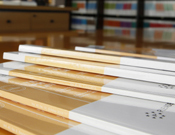Article
Heat and Mass Transfer and Physical Gasdynamics
2000. V. 38. № 3. P. 434–443
Labusov A.N., Lapin Yu.V.
Algebraic model of turbulent boundary layer on a convex curvilinear surface
Annotation
A simple algebraic model of turbulent boundary layer on convex curvilinear surfaces is suggested that is based on the generalization of the two-layer one-parameter algebraic model for a flat plate [1]. The model is tested in a wide range of variation of the curvature parameter ($0.01\le\delta_0/R_w\le0.09$, where $\delta_0$ is the thickness of the boundary layer at the initial cross section of the curvilinear region and $R_w$ is the curvature radius of the surface), the results of which are indicative of a good agreement between the experimental and calculated data on the integral characteristics of the boundary layer, namely, the friction coefficient $c_f$, the displacement thickness $\delta^*$ and momentum thickness $\delta^{**}$, and the form parameter $H=\delta^*/\delta^{**}$. Based on the comparison between the calculated and experimental data on the distribution of tangential turbulent stresses, a conclusion is made that the model predicts a much lower effect of the curvature on the suppression of turbulence in the outer region of boundary layers at a mild curvature of the surface $(\delta_0/R_w=0.01)$ than in experiments. However, this difference has a tendency to decrease as the surface curvature increases. An analysis of the calculated and experimental velocity profiles plotted in the variables of the wall law leads to a conclusion that the generalized Townsend wall law is partially realized on a curvilinear surface.
Article reference:
Labusov A.N., Lapin Yu.V. Algebraic model of turbulent boundary layer on a convex curvilinear surface, High Temp., 2000. V. 38. № 3. P. 434
Labusov A.N., Lapin Yu.V. Algebraic model of turbulent boundary layer on a convex curvilinear surface, High Temp., 2000. V. 38. № 3. P. 434







